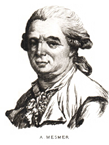Early life
Let us however survey the captivating story of his life [1]: F. Anton Mesmer was born on 23 May 1734, in the village of Iznang near Radolfszell, which lies by the shores of Lake Constance in Swabia.

Radolfszell in an old postcard
He attended the school run by the Jesuits, both on account, ostensibly, of the protection extended to him by the Bishop of Constance, which Mesmer’s father served as his personal forester, and on account of the brilliant innate qualities of his intellect. Mesmer grew up by the countryside. His eyes had the advantage of being enchanted by sublime landscapes: The blue waters of the lake reflected the lofty peaks which were coated by snow all the way till spring.

Iznang, in front of Radolszell in an ancient postcard
When spring came, the trees would be covered by red and white flowers.

Every season brought with it its own distinct kind of sensations. Nature’s giant book was thrown open in front of his sight.

A photo of the lake of Constance near Iznang
He drew indeed greater benefit from Nature’s teaching than those he received from his schoolmaster. It has been related that, while still a child, he had a most gripping keenness to come to know the wellsprings of brooks, the course of which he would thus follow backwards until he succeeded in identifying their source: This is a pointer to his pronounced inclination towards researching causes, as well as the prelude to the discoveries he was destined to make. During these years of freedom, his faculty of observation became sharper. He accordingly discerned a fact which later led him to the discovery of animal magnetism: Whenever he drew close to a sick person who was bleeding, he would notice that the bleeding slowed down, whereas it accelerated the moment he moved away from his presence. The inference he drew from it was that something comparable to what healers would put in practice by touching their patients was taking place. The eagerness to ascertain what lay at the root of the said phenomenon had already taken a firm hold on him. At the age of 16, Mesmer was as educated as his schoolmates in spite of his frequent outings to the countryside. Thereafter, he pursued his studies further. The only certain thing about this period is that, after completing his education, he refused to devote himself to theology, a discipline he had been earmarked for, preferring instead to consecrate his self to philosophy. It is here that he obtained his first diploma as doctor in 1759. Thereafter, he dedicated himself to medicine. This phase of his life is little known. We might cogently surmise that he simultaneously carried out secret studies of astrology, alchemy and physics (given that they represented largely banned sciences by then).

Mercury, that in alchemists’ work share some of the characteristics of Mesmeric fluid
As for medicine, he studied that science under the celebrious Van Swietten, one of the greatest German doctors of that age. He became a doctor in Vienna in 1766. Van Swietten himself wrote a note of encomium for the doctoral thesis Mesmer had submitted. Still in Wien, Mesmer came to know Mozart, who befriended him. He attended, in Mozart’s company, the gatherings of a number of esoteric circles, and was appreciative of the magnetic power his music possessed.

An image from Die Zauberflöte
The Opera “Die Zauberflöte (The Magic Flute)” belongs to this period and bears the imprints of such esoteric fascination. Mesmer himself was a virtuoso of the harpsichord and the cello.
The advent of animal magnetism
Once he became settled in that European capital, he successfully practiced medicine in it as well. Step by step, he perfected his theory. Mesmer began to apply magnetism to the treatment of diseases in 1772. His researches immediately aroused interest, and he was therefore invited to speak at conferences in Swabia, Switzerland, Hungary and Bavaria. Mesmer often expressed his forceful disapproval of whoever ascribed his healing achievements to some supernatural power, and used to stress the fact that his therapy was but a causative agent which everybody was capable of developing. His vast erudition, however, had elevated him to the status of a formidable competitor. His colleagues, stirred by jealousy, disparaged his toils. The knowledgeable bodies of academics, incited against his person by a member of the Society of Jesus, meted out disdain to the fruit of his efforts. The court, too, meddled in the matter, and, at last, he was issued with an order to leave the states under the Emperor’s rule. After he retired from public life in Bavaria, hosted by the Elector, the only one among the Germanic potentates who had understood him, he was in a position to live a quiet life under the protection of such an enlightened prince. In spite of that opportunity, he yearned to accomplish more, as it happens to all those men who believe they are entrusted with a great secret. No doubt the France of the philosophers and the encyclopaedists would have seemed to him to be the nation with the greatest propensity to welcome new ideas. He accordingly arrived in Paris in 1778 [2]. He was 44 years old by then. He addressed the knowledgeable bodies, pleading with their members to examine his doctrine, which was encapsulated in the under-mentioned famous twenty-seven enunciations of his.

The knowledgeable bodies, however, examined nothing, and contented themselves with feigning an examination of Mesmer’s novel doctrine. The radical nature of his principles, as well as his assertion that it was possible to cure all diseases through a single remedy, brought upon his person the Faculty’s vituperation. The Royal Society of Medicine and the Academy of the Sciences, which were interconnected by joint membership to the sane coterie, did not extend any better welcome to his submissions. In the course of nearly four years, while the said dogged fight was going on, Mesmer, with unparalleled cynicism, was mocked, insulted, vilified, and turned into a caricature, into a song, a target of ludicrous embodiment of venality, arrogance and disloyalty, in spite or rather because of the successes he had reaped throughout the world, as well as the warm protection he had received from the queen, not to mention the government’s tacit approval.
He triumphed over such intrigue in an indirect manner, Having temporarily retired, he returned to Lake Constance after the days he had spent therein in his childhood. He returned to Nature and strove to get as far as he could to the bottom of natural knowledge. Guided by his belief that language and reasoning prevented man from gaining instinctive access to the foundation of his natural power, he went through an intense exercise, steering clear of inner dialogue for a period of three consecutive months.

Following his period, he came back strengthened, with his senses heightened and an even greater magnetic power. From an initial platform of qualities which were already of an eminently higher calibre, as he was knowledgeable, an artist, humorous, amiable and handsome, he further acquired at that stage an extraordinary hold on the frequenters of salons. He was, as per Deslon’s description, “a fiery soul in a body of iron”. Such a broad range of pleasing personal qualities won for him the admiration of the prominent personalities and the support of the noblewomen. There was no elegant lady in Paris who did not pay him a visit: Both noblewomen and bourgeois ladies took turns in extolling him. This special esteem in which he was held by members of the gentle sex was said to be a most important factor contributing to the rise of his reputation. Propelled forward by such powerful engine, his renown within the public opinion grew so much that the esteem he enjoyed surpassed Voltaire’s. The thinking world had split with regard to him into two opposite encampments, believers and sceptics, who fiercely vied with one another for supremacy. No man, particularly a foreigner, boasted a power comparable to his in the whole of France; he used to deal with reigning monarchs as one of their peers.
He was not allowed by the twists of fate, however, to derive enduring advantage from such brilliant social position. Due to the envy and hatred he had aroused among the erudite people, by offering resistance to the prevalent general opinion, he announced his intention to go back to Germany. Whether such announcement was a bluff, as his foes alleged, or it was caused by exhaustion and disappointment, the fact remains that his stated resolution worried the aristocracy. Louis XVI, under pressure to persuade him to stay, which was brought to bear by the high echelons of the kingdom, offered him a stable allowance of sixty thousand “livres” together with a splendid dwelling, which jointly amounted to a capital in excess of one million “livres”. This austere man declined such offer, stating that he wanted no favour, but only the scientific examination of his discovery. Having retired in 1781 to Spa’s thermal baths, where he once more embraced forests and Nature, and where, in 1782, the Marquise de Fleury urged him to open up a nursing home, he was soon summoned back to his trade by the intelligent voice of some four hundred good-hearted people, the pick of noblemen, scientists and jurists, who raised funds in order to be initiated to his doctrine, and set up an association called the Harmony Society in order to disseminate the benefits derived from it.
The Harmony Society
As Mesmer, therefore, found himself, thanks to the generosity of his students, the owner of a capital which nearly equalled the one the king had offered him, he decided to busy himself with the task of establishing, in the major cities, a network of premises which were suited to the free of charge treatment of sick people pursuant to his method. He travelled for the sake of actualizing such goal, quite extensively as far as France is concerned. The divulgation of his ideas was constantly on the rise. The Harmony Society boasted booming branches in Strasbourg (the Marquis of Puysegur), Chartres, Lyon (Jean-Baptise Wuillermoz), Amiens, Narbonne, Malta, San Domingo, and so on. The doctrine had been set out in the book called “Théorie du monde et des etres organisés”, which had been edited by Bergasse. In 1784, the Harmony Society (La Societé de l’Harmonie) witnessed his heyday. Puysegur in Buzancy, Orelut in Lyon, and Giraud in Turin, all published reports of bouts of healing. Meanwhile Lafayette guided Washington on a tour of the Harmony Society on the day following the conclusion of the Versailles Treaty. In 1784, however, one of his disciplines, Deslon, was once again subjected to an examination by one of the commissions of the Academy, which had refuted animal magnetism. In addition, a secret report addressed to the King at the same time stressed the possibility that magnetism might lead to attacks being mounted against social decorum by encouraging intermingling between men and women. It was, however, mostly due to a number of internecine struggles of an economic nature which plagued the Harmony Society, that Mesmer, who felt the figures recorded in its accounting books were being intentionally tampered with, decided to settle for 20000 francs and be free to leave the country, which he did in 1785, boosted by a hefty sum he was able to carry along. Once he was gone, his opponents went on a rampage, causing Mesmer to spend a lot of time writing retorting libels which targeted their accusations. He spent a short time in London before he set out for Italy and Germany, while still making some trips to France, strictly in disguise. He was for example spotted in Paris on the day of the public execution of Bailly, who had been one of his most passionate antagonists and had chaired the 1784 Commission. Mesmer was the only person, amid an audience intoxicated by fury or paralyzed by fear, to cordially greet him [3]. Immediately thereafter, in fact, the revolution broke out in 1789. Its avalanche caught his noble disciples as well. Nearly all the members of this cream of gentlemen, perched at that time on the summit of the collapsing building, atoned for their errors. As for the rest, they forgot about mesmerism, embroiled as they were in the unfolding of such colossal drama. Meanwhile, the creator of mesmerism sympathized with many of the ideas the revolution had highlighted. The consequence thereof is that he had to forego the plan of settling back in Wien, since he was viewed as politically suspect, and he retraced his steps to Paris several times. In 1802, while in that city, he asked for and was awarded a yearly allowance of 3000 florins as compensation for the money he had lost in the Revolution. In 1803, some of his friends solicited him to open up a new establishment devoted to the implementation of magnetic treatments, but Mesmer turned down their request. The war had consigned him to inaction; several friends of his had died, and he decided instead to take up residence in Switzerland. In 1809, he penned a letter to one of his friends, wherein he mentioned to him that he was spending a happy life of quiet and anonymity, untroubled by problems or by neighbours and people who could recognize him. He added in that missive, though, that he was still practicing his Art, and was always visited by plentiful patients, many of whom he would treat free of charge. In the meantime, the Academy of Berlin formally acknowledged the validity of Mesmer’s ideas and dispatched Prof. Wolfart to him with a view to inviting him to move to Berlin in Germany. However, Mesmer, who was by then an old man, was no longer keen to travel. Prof. Wolfart accordingly collected his memories, all the way until Mesmer met his death in Switzerland, on 5 March 1815.
After Mesmer
His stormy life, his doctrine and the events which saw him as a protagonist are superbly summarised in the following extract from a letter he wrote to a friend of his in 1783 :
«My existence resembles the life of those men who, by combining strong and far-ranging ideas, have reached either a big lie or a big truth. Such people belong to that error or that truth, and, depending on whether the same is accepted or rejected, they live amid admiration or die in unfortunate conditions. However hard they try to regain their primordial independence, to detach their destiny, that is, from the one befalling the system they have originated, all they do is to engage in futile efforts. Their work is akin to Sisyphus’ -, since the latter, regardless of his actual intention, causes the rock smashing him to pieces to fall over his body: Nothing can remove them from the work they themselves have imposed on their persons».
Afterwards, France, too, witnessed a number of turnabouts, while in 1831 the Royal Academy of Paris recognized the existence of animal magnetism, as well as the wonderful effects of induced somnambulism. Once Mesmer had proven his doctrine through the medium of unexpected instances of healing, which were visible and undoubted witnesses of the truth, magnetism was confronted by the most intriguing passions being unleashed against it, and it was compelled to endure an unceasing fight against numerous and powerful adversaries. Such bitter wrangle has invariably gone one, with greater or lesser fierceness, between defenders and opponents of the new science. It eventually reached a censurable degree, since insults and slanders lay bare men’s stark selfishness without contributing to genuine scientific progress one bit. If we leave aside all the irritating aspects one can discern in those attacks and the replies thereto, I believe we will find greater usefulness and significance in paying intelligent attention to the fact that the issues were studied and acknowledged by the scientific institutions, first and foremost the Royal Academy of Medicine in Paris itself, as it was forced, by the sheer logic of plain facts, to pay tribute to the truth. In 1784, some commissioners, who were selected from the whole spectrum of scientific bodies, were entrusted by the King with the task of conducting researches and experiments on animal magnetism, so that the government might be enabled to reach a decision on the degree of trust to be extended to the effectiveness of the influence exercised by such method. I will abstain here from addressing the issue of the malevolence which characterized the way the said commission discharged its mandate. Suffice it to say that the final report it drew up was totally inimical to Mesmer’s doctrine, though the famous Jussieu, one of the commissioners, refused to sign it as it did not express the truth, and authored instead a dissenting report, in which he carefully enumerated the facts that had been intentionally omitted or distorted by the first report (the majority one). The step he took gave rise to rumours and high-profile scandals which rocked the upper echelons of the scientific elite. The general public, however, was strongly moved by Jussieu’s alternative report, whereupon the cause of magnetism was embraced by a sizeable number of new supporters. In 1825, Doctor Foissac addressed to the Academy a memory in which he proved that the time had come to submit magnetism to a new examination. This memory was taken into account. The Academy then examined anew ... whether it should engage in a re-examination of magnetism in the first place. As a commission appointed by the Academy had issued its motivated opinion that such re-examination was appropriate, the opponents of magnetism deployed the oddest arguments against the said opinion, which are set out here under:
— If, one of such antagonists said, the hopes of magnetism are raised once more, we will soon be forced to halt our courses and shut down our schools, waiting for them to be conclusively demolished. — Another such adversary was afraid that, with the help of distance magnetism, some magnetizer might burst out from his attic in Paris and eventually dethrone the rulers of China and Japan. — Yet a third such foe could only countenance the existence of two classes of magnetizers: Deceivers and deceived. Notwithstanding such assortment of hostile arguments, the commission settled the matter by favouring the said opinion. One of the remarkable reasons it adduced as the basis for supporting such opinion was its declaration that « the judgment passed in 1784» by the commissioners mandated by the King to examine animal magnetism should in no way derogate from the need to carry out a new examination, since in the field of sciences no judgment whatsoever should be taken as being absolute and irrevocable in nature».
On 14 February 1826, the aforesaid opinion was adopted with a favourable vote of thirty-five to twenty-five, as a result of which, on the 25th day of the selfsame month, a new commission was vested with the duty to conduct a renewed examination of magnetism. After a six-year period of studies and conscientious researches, along with a large number of corroborating facts, the commission, in its report drawn up in June 1831, declared that magnetic action had the ability to triumph over diseases which were impregnable to the most vigorous therapies. The existence of the science of magnetism was thus officially recognized by virtue of this favourable formal report. In the course of the subsequent centuries, however, the battle between ruling academy and magnetists resumed. There are currently bodies of national legislation, such as the one in Germany, which grant explicit and official recognition to the existence of alternative therapeutic methods, including those associated with naturopathy or based on magnetism, along with other varieties which we do not intend to tackle in this context. The fact that something simple, endowed with immediate validity and capable of restoring well-being, might give birth to conflicting opinions which, while taking care never to question the instances of healing, nevertheless tend to construct different explanations in spite of the fact that the simplest explanation of such phenomena constantly comes back to the fore and yet finds it hard to earn acceptance by the mind, is the subject matter dealt with by our document specifically devoted to such conundrum, which is titled “A scientific approach to Animal Magnetism” and analyses the reasons behind that whole approach.
